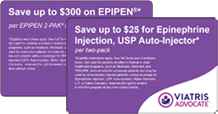
Preparing your at-risk patients
Helping your patients be prepared with an anaphylaxis action plan is an important part of managing the risk of a life-threatening allergic reaction.1
For your patients at increased risk, being prepared means1:
- Avoiding known allergens
- Knowing what symptoms to watch for
- Using an EPIPEN® (epinephrine injection, USP) Auto-Injector (or its authorized generic) if a life-threatening (severe) allergic reaction occurs
- Getting emergency medical help right away
It is important to communicate to your patients that if they, their child or someone they’re caring for shows signs or symptoms of an anaphylactic reaction, they should inject EPIPEN or EPIPEN JR® (epinephrine injection, USP) Auto-Injector—or their authorized generics—immediately and seek emergency medical attention.2,5
After administering an initial dose of epinephrine, the NIAID Expert Panel recommends transfer to an emergency facility for observation (4-6 hours or longer, depending on severity of the reaction) and possible further treatment.1 More than two sequential doses of epinephrine should be administered only under direct medical supervision.2,3
Acute anaphylactic reaction management
Because anaphylaxis symptoms may progress rapidly and become life threatening, it is important that treatment with epinephrine be initiated promptly.5-7
According to guidelines developed by the National Institute of Allergy and Infectious Diseases (NIAID) Expert Panel, treatment for food-induced anaphylaxis should focus on1:
- Prompt and rapid treatment after onset of symptoms
- Intramuscular (IM) epinephrine as first-line therapy
- Other treatments, which are adjunctive to epinephrine dosing
The Expert Panel recommends that initial management begin with the following concurrent steps1:
- Elimination of additional allergen exposure
- IM injection of epinephrine
- Call for help (911 or equivalent) after administering epinephrine
Is epinephrine appropriate treatment for all cases of anaphylaxis?
According to the NIAID Expert Panel, “Epinephrine is the first-line treatment in all cases of anaphylaxis. All other drugs have a delayed onset of action.”1
When a second dose of epinephrine may be warranted
In cases of suboptimal response to the initial dose of epinephrine, or if symptoms progress, the NIAID Expert Panel recommends repeat epinephrine dosing as first-line therapy over adjunctive treatments.1
NIAID food allergy guidelines recommend at-risk patients have access to two epinephrine auto-injectors.1 More than two sequential doses of epinephrine should only be administered under medical supervision.2,3
According to the NIAID food allergy guidelines, there are two reasons that patients should carry two doses of their epinephrine auto-injector1,5:
1. 20% of patients may need a second dose due to ongoing symptoms1,4
6.3.1.1 Epinephrine—first-line treatment
“If a patient responds poorly to the initial dose or has ongoing or progressive symptoms despite initial dosing, repeated dosing may be required after 5 to 15 minutes. Reports of patients receiving epinephrine for food-induced or non-food-induced anaphylaxis note that as high as 10%-20% of individuals who receive epinephrine will require more than 1 dose before recovery of symptoms.”1
2. 20% of patients may experience a biphasic reaction1
6.2.3 Time course of food-induced anaphylaxis
“A biphasic reaction includes a recurrence of symptoms that develops after apparent resolution of the initial reaction. Biphasic reactions have been reported to occur in 1%-20% of anaphylaxis episodes and typically occur about 8 hours after the first reaction, although recurrences have been reported up to 72 hours later.”1
What about antihistamines?
A 2014 survey of caregivers and patients with reported anaphylaxis showed that 36% planned to use an antihistamine to treat future episodes of anaphylaxis, despite the fact that antihistamines are not indicated to treat the life-threatening symptoms of anaphylaxis.1,9
Antihistamines do not relieve shortness of breath, wheezing, gastrointestinal symptoms or shock. Therefore, antihistamines should be considered adjunctive therapy and should not be substituted for epinephrine.1
According to the NIAID guidelines, use of antihistamines is the most common reason reported for not using epinephrine and may place a patient at a significantly increased risk for progression toward a life-threatening reaction.1
Special Offers
Viatris offers Access and Savings Programs for eligible patients. See Terms and Conditions.
There’s only one recommended first-line treatment for anaphylaxis.
heading
Important Safety Information (the following information applies to both EPIPEN and its Authorized Generic)
EPIPEN (epinephrine injection, USP) 0.3 mg and EPIPEN JR (epinephrine injection, USP) 0.15 mg Auto-Injectors are intended for immediate administration as emergency supportive therapy only and are not intended as a substitute for immediate medical or hospital care. In conjunction with the administration of epinephrine, the patient should seek immediate medical or hospital care. More than two sequential doses of epinephrine should only be administered under direct medical supervision.
Rare cases of serious skin and soft tissue infections have been reported following epinephrine injection.
References
- Boyce JA, Assa’ad A, Burks AW, et al. Guidelines for the diagnosis and management of food allergy in the United States: report of the NIAID-sponsored expert panel. J Allergy Clin Immunol. 2010;126(6 suppl):S1-S58.
- EPIPEN (epinephrine) injection. Prescribing & Patient Information. 2023. Mylan Specialty L.P. Morgantown WV.
- EPINEPHRINE (epinephrine) injection. Prescribing & Patient Information. 2023. Mylan Specialty L.P. Morgantown WV.
- Simons FE. Anaphylaxis. J Allergy Clin Immunol. 2010;125(2)(suppl 2):S161-S181.
- Simons FE, Ardusso LR, Bilὸ MB, et al; World Allergy Organization. World Allergy Organization guidelines for the assessment and management of anaphylaxis. World Allergy Organ J. 2011;4(2):13-37.
- Lieberman P, Nicklas RA, Randolph C, et al. Anaphylaxis—a practice parameter update 2015. Ann Allergy Asthma Immunol. 2015;115(5):341-384
- Volcheck GW. Clinical Allergy: Diagnosis and Management. Rochester, MN: Mayo Foundation for Medical Education and Research; 2009.
- Simons FE. Anaphylaxis: recent advances in assessment and treatment. J Allergy Clin Immunol. 2009;124(4):625-636.
- Wood RA, Camargo CA Jr, Lieberman P, et al. Anaphylaxis in America: the prevalence and characteristics of anaphylaxis in the United States. J Allergy Clin Immunol. 2014;133(2):461-467.

This site is intended for US healthcare professionals.
If you are a patient, please check out our site for patients.

Prescribing Information
Please select from the following:

Patient Information
Please select from the following:



